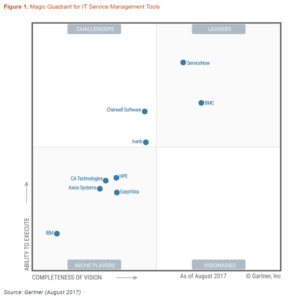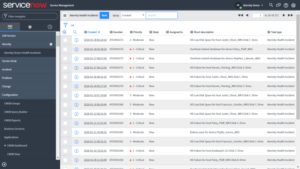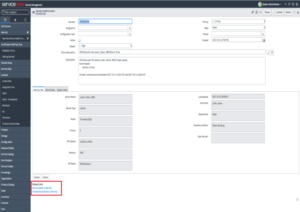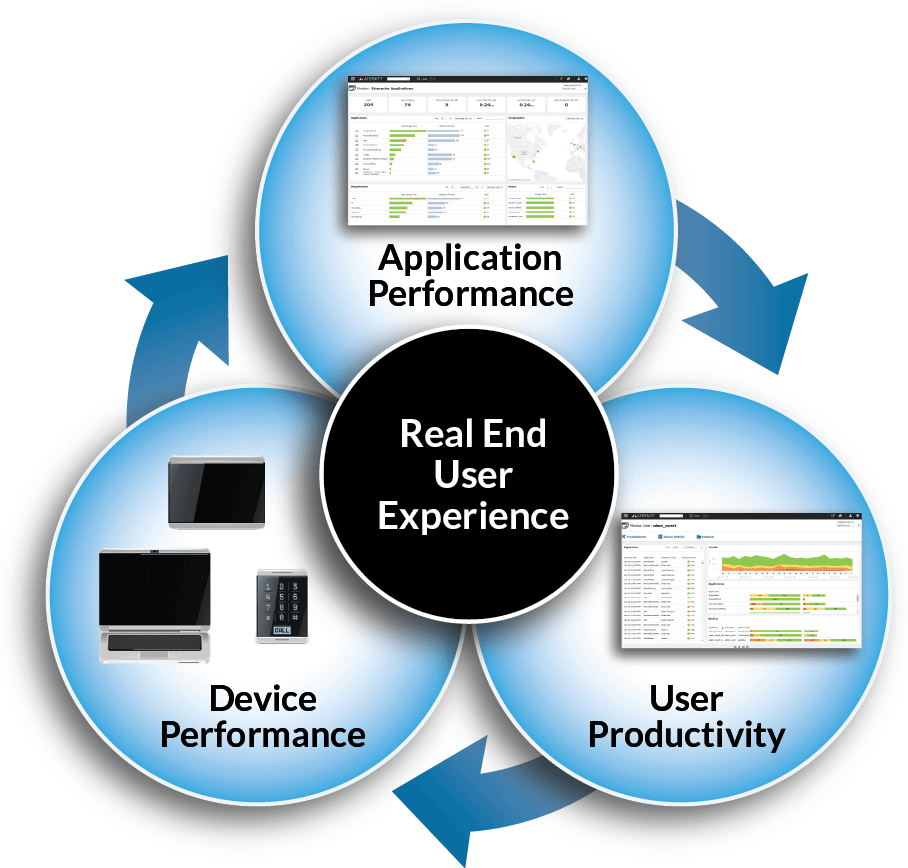Aternity and ServiceNow – Driving up Service Desk Efficiency and Quality
 To address the challenges of today’s Service Desk teams, SteelCentral has released a bi-directional integration between SteelCentral Aternity and ServiceNow, the market-leading IT Service Management (ITSM) vendor. The role of the Service Desk has never been more important, or more pressure-packed. Companies are deploying a more complex mix of technologies as part of their digital transformation efforts. Not just devices—PCs, tablets, smart phones, etc. But applications too—mobile apps, apps running in the cloud, third party SaaS offerings, and apps running in virtual environments. Service Desk staff are on the front lines to handle customer issues on all of these.
To address the challenges of today’s Service Desk teams, SteelCentral has released a bi-directional integration between SteelCentral Aternity and ServiceNow, the market-leading IT Service Management (ITSM) vendor. The role of the Service Desk has never been more important, or more pressure-packed. Companies are deploying a more complex mix of technologies as part of their digital transformation efforts. Not just devices—PCs, tablets, smart phones, etc. But applications too—mobile apps, apps running in the cloud, third party SaaS offerings, and apps running in virtual environments. Service Desk staff are on the front lines to handle customer issues on all of these.
As companies compete to roll out better services, faster and at lower cost, Service Desk teams must identify and resolve problems more rapidly. One of the primary Service Desk Key Performance Indicators (KPIs) is Mean Time to Repair. Reducing MTTR improves both Service Desk staff efficiency and quality. Without the right tools to proactively find and fix issues, costs go up, productivity goes down, and end user satisfaction goes down along with it.
Your Service Desk team may be part of the enterprise IT staff. Or it may be part of a service offered by IT outsourcers, like DXC, Unisys, or Dimension Data, or by an MSP like BlueAlly. No matter the case, the integration of Aternity and ServiceNow helps you meet these challenges. Watch this short video to see it in action:
ServiceNow is a Leader in the Gartner Magic Quadrant for ITSM Tools
 According to the Gartner Magic Quadrant for IT Service Management Tools, ServiceNow is one of two vendors in the “Leaders” quadrant. Gartner states that ServiceNow’s IT Service Management (ITSM) tool has twice the revenue market share of its nearest competitor. Indeed, many of Riverbed’s enterprise customers have standardized on ServiceNow for their Service Desk teams. And several of Riverbed’s IT outsourcing and MSP partners also use ServiceNow as part of their offers for managed end user services.
According to the Gartner Magic Quadrant for IT Service Management Tools, ServiceNow is one of two vendors in the “Leaders” quadrant. Gartner states that ServiceNow’s IT Service Management (ITSM) tool has twice the revenue market share of its nearest competitor. Indeed, many of Riverbed’s enterprise customers have standardized on ServiceNow for their Service Desk teams. And several of Riverbed’s IT outsourcing and MSP partners also use ServiceNow as part of their offers for managed end user services.
Gartner classifies products in this category by both their ITSM capabilities and their integration with other tools in the IT Operations Management (ITOM) segment. Although every analyst firm defines the ITOM market differently, Gartner separates ITOM into three sub-categories, called Experience Management, Delivery Automation, and Performance Analysis. SteelCentral resides primarily in the last sub-category – products that monitor the availability and performance of applications, infrastructure, and networks. So, the integration of Aternity and ServiceNow also enhances ServiceNow’s market position.
Improving service desk efficiency with Aternity and ServiceNow
The new integration of Aternity and ServiceNow helps you improve the efficiency and the quality of your Service Desk operations.
Service Desk efficiency is driven by the amount of time a Service Desk team member spends resolving an incident. You can improve efficiency by speeding up the time required to identify and resolve the cause of the issue, either at the Service Desk or at Level 2 or 3. Efficiency, Mean Time to Repair, and cost per ticket, are therefore directly related.
Aternity tracks device health problems like application crashes, update failures, memory or disk trouble, hard drive failures, battery issues, and Blue Screens of Death.
Aternity triggers a service desk alert when the same application, hardware, or system problem occurs within a specified period of time. For example, it can trigger a service desk alert whenever your ERP application crashes more than twice a day on any device in any location, or when the same device has a system crash (BSOD) more than twice in a seven day period.
The integration between Aternity and ServiceNow enables Aternity device health alerts to automatically generate incidents in ServiceNow. The ServiceNow Incident Table shows the Aternity Health Incidents, listed in chronological order with the most recent incidents on top. Proactive notification of device incidents enables your Service Desk staff to act on issues more quickly, without waiting for a user to call to complain.

Aternity device health alerts automatically generate incidents in ServiceNow
Raising service desk quality with Aternity and ServiceNow
Quality is another primary KPI for Service Desk operations. One of the key drivers of quality is First Level Resolution – the ability of your Service Desk team to resolve tickets at Level 1, without having to route the ticket to Level 2 or 3 support teams.
The bi-directional integration between Aternity and ServiceNow provides a closed-loop troubleshooting flow that enables your Service Desk team to maximize the number of incidents it can resolve. The ServiceNow incident is populated with all of the detailed Aternity information on device parameters and user profile. This provides your Service Desk staff with all of the information they need to understand the issue.
In order to identify and resolve the issue, the Service Desk technician can drill down into the details of the end user’s device by launching the relevant Aternity dashboard.

The ServiceNow incident is populated with relevant user and device data. The Service Desk technician can immediately launch the relevant Aternity dashboards to investigate the issue.
Another key driver of Service Desk quality is a related KPI, First Contact Resolution (FCR). FCR refers to the ability of the IT team to resolve a user’s issues on their first contact, whether at the Service Desk, or at higher levels of support. The integrations between Aternity and AppInternals and between Aternity and NetProfiler help improve FCR for app and network related issues, respectively.
Aternity’s advantage in End User Experience Monitoring

Aternity monitors the three streams of data that constitute end user experience
Unlike Device Performance Management (DPM) products like Nexthink, Lakeside, and Liquidware Labs, Aternity automatically monitors and correlates together the three streams of data that constitute true user experience. These are user interactions, device health and performance, and application performance, as seen by the end user. The correlation of these three streams helps IT teams determine whether the cause of the problem lies with the device, the application, or the user. Armed with this information, the Service Desk can quickly determine whether they can solve the issue themselves, or whether they need to escalate to another team.
Although DPM products also have integrations to ServiceNow, they can generally see only one of these streams—device health and performance. Although some can see app crashes, they cannot see how applications render on the screen of the device. And they do not monitor the user’s behavior—what the user is actually doing with that application. Aternity provides a broader view of end user experience that enables the Service Desk staff to better identify and resolve end user incidents.
Start improving your service desk operations today!
 If you’re ready to take the first step to improving your Service Desk efficiency and quality with Aternity and ServiceNow, you can get started today. First, explore Aternity on its own. Register for instant access to Aternity running in our cloud environment to explore all of Aternity’s use cases.
If you’re ready to take the first step to improving your Service Desk efficiency and quality with Aternity and ServiceNow, you can get started today. First, explore Aternity on its own. Register for instant access to Aternity running in our cloud environment to explore all of Aternity’s use cases.
